
 |
|
|
|
Portrait of Jason is a fascinating underground feature famous for teasing the limitations of objective filmmaking. Some think that it challenges the validity of the documentary form. Clarke filmed her controversial subject for twelve hours straight. We spend the entire show with Jason Holiday (birth name Aaron Payne), self-described hustler, houseboy and aspiring cabaret performer. A gay black man at time when gay sex was illegal in most states, Jason lived a dodgy life doing "whatever needed to be done to get by." In the process, he invented a hipster personality for himself. When he talks, he's playing a role. 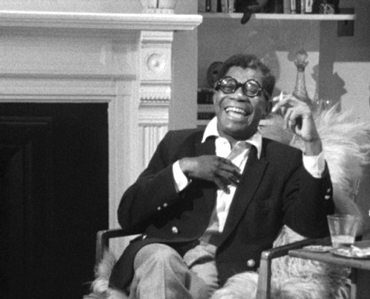
We learn this and much more in Portrait of Jason, which consists of shots of Holiday talking about himself while drinking in Clarke's apartment in The Hotel Chelsea. Ms. Clarke lets us know the setup right from the beginning. There is no narration or explanatory titles, and no titles or credits of any kind. When a camera film roll runs out, the screen goes black and we hear Clarke telling the soundman to keep rolling. Several seconds later a new magazine has been loaded and the picture resumes again. No attempt is made to hide these 'rough edges'. The editing is a series of simple choices to either use or not use footage; there is no montage cutting and little if any tightening of speeches. The Academy Film Archive performed the film restoration, retaining Clarke's exact cutting. Jason's self-invented public personality is "on" from the beginning, as he regales the camera with hipster monologues. Some of his talk is explicit about the sex and drugs in his life, but he also uses euphemisms and verbal sidesteps to steer away from places he doesn't want to go. For screenings in Sweden Clarke provided a glossary of Jason's hipster terminology, explaining expressions from 'uptight' and 'roach' to 'balling' and 'Sparkle Plenty.' We are left to guess what his full duties were when working as a houseboy to wealthy women. Witnessing the filming were just the three-man crew and a couple of observers. Jason talks as if holding court in a cabaret, taking pains to be entertaining and congenial. He embellishes his reputation, laughs at his own jokes, and assures his audience that he's telling the truth. We're at all times aware that Shirley Clarke is present, as many takes begin with her verbal prompts. She'll say, "Tell us the cop story" and Jason will begin a new monologue. Clarke had known Holiday as a colorful 'guy on the scene,' one of many eccentric New York personalities in search of fame. He apparently told the same stories at parties, as if they were material for his standup act. Clarke later said that Andy Warhol tried to do something on film with Jason and Edie Sedgwick, but it didn't work out. Jason would seem a likely contender for the Warhol school of celebrity. Clarke's editorial task was to extract and arrange the most interesting material from the twelve-hour session. Jason drinks and smokes through the night, becoming more mellow as the hours click by. Cameraman Jeri Sopanen frequently shifts the camera purposely in and out of focus. Jason is a blur while gathering his thoughts, and then the focus racks to clarity as he gets rolling on a particular story. The cameraman provides the same kind of "focus punctuation" when Jason finishes a speech. After the figurative punch line, as Jason resumes his small talk, the focus is thrown out again to bring the 'scene' to a close. A documentary camera operator can become a de facto director as well. 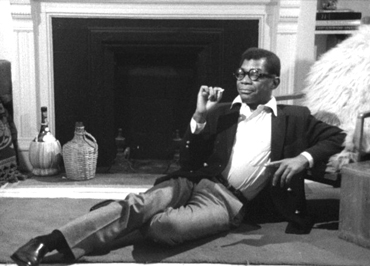
In 1967 a film with an openly gay man talking about his lifestyle in an exhibitionist manner was by its nature controversial. Holiday is a funny and charming lounge lizard. He's also sufficiently intelligent to be judicious about what he thinks his audience can and cannot handle. At one point he recalls a thoughtless racist remark from one of his lady employers, and we realize that he must endure casual offences like this on a daily basis. He pretends to have a thick skin, but we can also sense his vulnerability. Jason hints that his employment can involve sexual services, but isn't comfortable being more specific. Before revealing too much he laughs and switches back to Funny Mode for another anecdote. At several points Holiday demonstrates an unexplainable 'cool' bit of body language, snapping his fingers while swinging his hand over his head in an offhand manner. The gesture expresses his laid-back attitude in a way that words cannot. A great deal of critical ink has been expended on Portrait of Jason's challenge to the notion of filmic objectivity. Frenchmen Edgar Morin and Jean Rouch used their entire 1960 film Chronicle of a Summer to ponder the practicality of cinéma vérité. Can people on film really 'be themselves', or does the presence of a camera inevitably alter their behavior? Shirley Clarke's movie suggests that the idea of "being ourselves" is also in doubt. We put on a different face for the public and act differently with our family than we do with our co-workers, etc.. Jason behaves like a celebrity with a persona to be maintained. Is there a "real" Jason Holiday / Aaron Payne? Is he 'living' a performance? 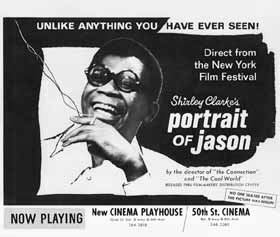
Jason sometimes seems very sincere, and at other times he's not much different than a guest on The Tonight Show. He carefully edits his checkered past in his monologues. He frequently refers to his shaky career as a cabaret performer -- he's even brought along a bag of hats used in his act. He affects speech patterns that remind us of characters from Tennessee Williams. Viewers unfamiliar with New York artistic fringe dwellers might conclude that he's seriously unbalanced, when he's merely adapted himself to an out-of-balance situation. Jason probably sees himself as a male, black, gay Holly Golightly. In the final minutes Jason becomes more serious and self-critical, and admits that he's lonely and unhappy. From off-camera, actor Carl Lee verbally badgers Holiday, pointing out his evasions and urging him to stop the BS and be more honest. Jason breaks down and cries. We cannot be certain that the tears are spontaneous, or if the clever fellow is merely providing a dramatic finish to his filmic portrait. Shirley Clarke later explained that she omitted more material in which she carried on the attack, reminding Jason of some inexcusable behavior and pressing him to face up to it. An extra titled The Lost Confrontation contains audio outtakes of the rejected sequence. Clarke says that when she saw it in the editing room, it no longer felt convincing: "I didn't believe it." The disc comes with several interesting extras. Jason Unleashed compiles more audio outtakes from cut material. Jason in Color! is about a minute of 16mm movies of Jason, filmed on the street in 1971 by Anton Perich. Jason Before and After is a restoration comparison. Courtesy of Regina Longo, we can also hear Jason's audio record, The Holliday Comedy Album. Shirley Clarke is interviewed by Pacifica Radio not long after the Jason Premiere. Butterfly is a 1967 antiwar short screened once at NYU. It optically combines Scratch-on-Film animation, color smears, images of Shirley and her daughter Wendy and an audio montage of baby sounds & guns firing. Shirley Clarke in Underground New York is a nicely edited war protest documentary featuring Shirley marching with Ginsburg, etc. Filmed on a Manhattan roof and in her editing room, she then makes a speech about the role of politically committed filmmakers. Finally, Where's Shirley? is a delightful Kickstarter promo featuring Milestone's Dennis & Amy Heller pitching the restoration of Jason, an amusing account of their archive searches from Paris to Sweden. Even their PowerPoint presentation is funny and impressive; they dress up Jason as "Where's Waldo" to identify him as the object of their search.
|
|
The documentary Ornette: Made in America stretches docu boundaries in a less radical way. Ornette Coleman is a saxophone musician and composer who invented the term 'free Jazz', a fascinating character and personality who defies compartmentalization. Another documentarian might have simply strung together the various filmed concerts. Clarke instead skips back and forth in Coleman's career timeline, in search of a 'free cinema' editing style to match her subject's music. 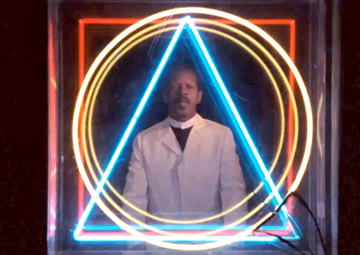
Clarke made an ongoing study of the iconoclast Texas Jazz man. The film combines shoots from as early as 1968 and pulls in film and video footage from all over the world. We see an Italian broadcast of part of a concert from 1980 as well as B&W video of Coleman performing with a group of Nigeria in 1972. Coleman is open and candid when he speaks, although the task of explaining his unusual style are left to colleagues and Jazz critics like Bob Palmer of the New York Times. Late in the show we hear testimony from Coleman's wife (poet Jayne Cortez) and sister about the years of rejection he endured. Jazz musicians expected their colleagues to harmonize with each other, but Ornette believed in individual expression. Musician James Clay recalls how other musicians would leave the bandstand when he played, in protest. We're told that Coleman was a fine technical musician as well. He could play beautiful 'straight' Jazz for fun. His command of the instrument is compared to that of Charlie Parker. He soon became a composer of works that combined his saxophone with an orchestra. Ornette: Made in America skips between different kinds of docu material. Taking a cue from an advertising sign with moving text, Clarke uses it to establish places, dates and new personalities. Coleman's son Denardo has drums with his father since he was a child. We see footage of the boy in 1968 being coached to express himself without restraint. Denardo appears again in '69 playing his father's "Sun Suite" with the San Francisco Symphony. We see Ornette playing Saxophone in the tent city erected for Martin Luther King's 1968 March on Washington.
The film expresses Coleman's relationship to his hometown of Fort Worth. Recent (1984?) footage shows him receiving the key to the city in advance of a major homecoming with his "Caravan of Dreams" at the Fort Worth Symphony Hall. Intercut with the performance are recreations
The editing maintains Coleman's restless spirit. Some sequences are from a lower resolution video that uses television switcher effects and video feedback. Clarke often flash-cuts Coleman's logo, a triangle superimposed over a circle. In other footage Ornette's associates William Burroughs and Brion Gysin talk about their creative conclave in Morocco in the early '70s; Bob Palmer apparently helped the artists link up. We later see Burroughs recite some of his poetry in Forth Worth. At the same concert Coleman dedicates his performance to his hero Buckminster Fuller, and we hear some of Fuller's words as well. 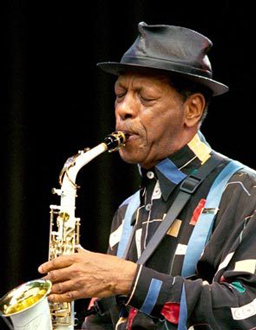
The film ends with more testimony, a concert in New York and a special event called "The Link", in which a satellite connection enables musicians at opposite ends of Manhattan to play together. One group is in Harlem and the other at the new World Trade Center towers. Ornette: Made in America is a fascinating document of an artist who had to wait years for his art to be recognized by both his peers and the critics. Producer Kathelin Hoffman Gray had possession of the 35mm elements for Ornette and Ross Lipman of the UCLA Film Archive was in charge of the restoration. The disc extras come from Shirley Clarke's later years at UCLA. Shirley Loves Felix is a playful video project that simply mattes Shirley, wearing a cat mask, over an ancient Felix the Cat cartoon, explaining how it brought joy to her childhood. Interview with Clarke is another UCLA tape in which Shirley sits on camera for an informal chat with her student director. The Link Revisited is an interview with Denardo Coleman done by Ross Lipman in 2013, on Skype. Denardo talks at length about his father and the progress of their careers. We also get two trailers for Ornette, and another radio interview with Shirley. 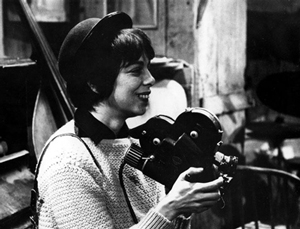
Milestone's Blu-rays of Portrait of Jason and Ornette: Made in America have been carefully produced as Volumes 2 and 3 of the company's "Project Shirley" effort. Portrait of Jason is fully rejuvenated; Milestone went to the expense of generating new 35mm prints as well. Ornette was assembled from many source formats, but Image Transform's tape to film transfers and Du Art Lab's work makes it all look fine. The music mix for Ornette Coleman's performances is in great shape as well. Both discs come with removable English subtitles; each is a separate release. How Milestone recovered an original film element is one of those amazing stories of film preservation. Initially, all that could be found of Portrait of Jason were some battered prints and edited copies. The Wisconsin Center for Film and Theater Research had some film cans labeled as outtakes. Noting that the cumulative running time for those outtakes approximated the length of the final feature, Milestone's Dennis Doros had them sent to Ross Lipman at the UCLA Film Archive, who confirmed that the reels were a16mm fine grain of the entire uncut feature. The film had been mistaken for outtakes because that's exactly what it looked like: Shirley wanted her show to look like raw film. As a rule archives don't save trims and outs. It was unusual that Wisconsin had even kept the material.
On a scale of Excellent, Good, Fair, and Poor,

The version of this review on the Savant main site has additional images, footnotes and credits information, and may be updated and annotated with reader input and graphics.
Review Staff | About DVD Talk | Newsletter Subscribe | Join DVD Talk Forum |
| |||||||||||||||||||||